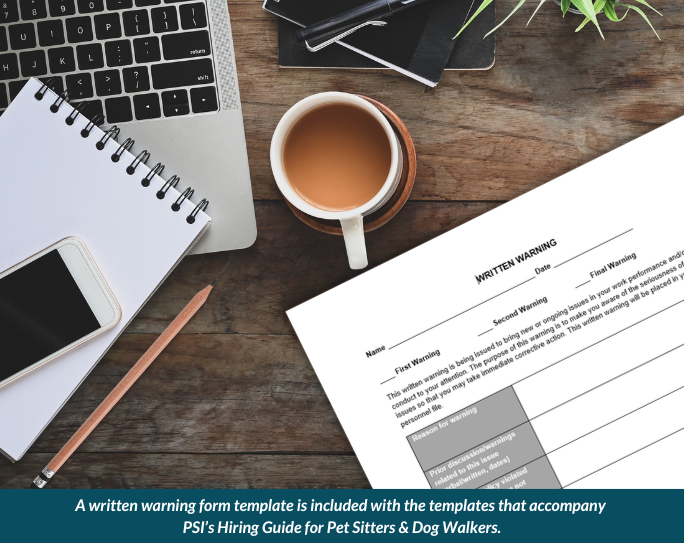What Pet Sitters Need to Know about Firing an Employee
PSI Staff | September 2023
While it’s not something business owners like to think about (especially when you are just starting the hiring process!), the reality is that if you have a team, you will at some point have to follow a disciplinary process with an employee. So, it’s important to have your disciplinary process in place from the beginning.

What should you do if you think you need to fire one of your pet-sitting company’s employees?
In most companies, there are four stages in the disciplinary procedure:
- Verbal warning
- Written warning (likely accompanied by a Performance Improvement Plan)
- Final written warning
- Dismissal
These steps of progressive discipline should give your employee the opportunity to work with you to address any issues and improve their performance. Please note, however, that there will be some actions that warrant immediate termination in lieu of this multi-step process.
Examples of gross misconduct that warrant immediate termination of employment include theft; acts of violence against people or pets; harassment of another employee, vendor or client; possession or being under the influence of illegal drugs while on company business; and unauthorized disclosure of confidential business or client information.
It’s important to ensure that your pet-care company’s disciplinary process adheres to any federal, state and/or local guidelines and that it is outlined in your employee handbook. When sharing your disciplinary process with employees, however, be sure to clarify that your company’s disciplinary procedures may be altered (in other words, steps may be combined or even skipped) depending upon the nature of the employees’ actions and that your policy does not impact the employment-at-will relationship they have with your company (if your business is in an at-will employment state).
So, let’s go over the four stages in most companies’ disciplinary procedure.
Verbal Warning
It’s important to maintain appropriate documentation throughout the disciplinary process. While the first step is a verbal warning, you should still follow up the conversation with written documentation (provided to the employee in person or via email) that they can sign to indicate they understand the issues that were brought to their attention, as well as the plan for improvement that was discussed.
Written Warning
The second step of your disciplinary process will be more formal. In addition to including a meeting to discuss an additional violation of company policies or continued performance issues, you should also explain to your employee the specific consequences that will take place if they do not improve and meet performance and/or behavior expectations.
The employee should be provided with a written copy of the warning to sign that also indicates that additional actions (up to and including termination) may result if these issues are not corrected.

At this step in the process, it is also advisable to provide the employee with a formal performance improvement plan (PIP, for short)—either at the meeting or shortly after. The PIP should outline a specific action plan that must take place—with specified deadlines—for the employee to correct the performance and/or behavior issues that have resulted in the warning(s).
Final Written Warning
Should employee issues continue and/or the parameters of the PIP not be adhered to, a final written warning will be issued. This is the last step in the progressive disciplinary process before termination of employment. In some cases, an employee will be suspended for a designated time frame (without pay) upon the issuance of a written warning. A final written warning should also include an expiration date (i.e., when the employee can return to work or when the specific disciplinary action ends), as employers cannot indefinitely suspend or discipline employees.
Dismissal/Termination
This is the last and most serious step in the progressive disciplinary process. Except for in extreme situations (like danger to you or other team members), you should meet with your team member in person to notify them of their termination. It’s advisable to keep your discussion brief but clear and refer to the progressive disciplinary steps you have taken prior to this termination.
Be sure, too, that you understand the legal obligations you may have to a terminated employee depending upon where your business is located. The U.S. Chamber of Commerce provides this advice: “Employers must fulfill certain legal obligations and provide a terminated employee with information about their benefits including COBRA, their last paycheck, unemployment options and transportability of other insurance. You may be tempted to deny unemployment benefits, but if you proceed, be prepared to fight claims of discrimination or wrongful termination.”
Other Considerations:

In addition to having a checklist of the legal obligations you must fulfill when firing an employee, don’t forget practical considerations specific to your business as well. For example, does this team member have client keys (or any other client forms or information) that they need to return to you? Or do they have client security codes (that you’ll need to notify clients to change)? Do you use pet-sitter software or other applications that you’ll need to turn off the employee’s access to?
If your business model includes your clients meeting or knowing the individual pet sitter that cares for their pets, you’ll also need to notify clients that the specific team member is no longer with your business and inform them who will assume the responsibility of care for their pets going forward. Remember that—while tempting—you should not share any details as to why a team member is no longer with your business, as this is confidential personnel information.
Some pet sitters will choose to leave of their own accord, not due to any disciplinary action or problems with the company, so don’t be discouraged when you have turnover. It is a natural part of running a business in the service industry.
Note: The following information is excerpted from PSI’s Hiring Guide for Pet Sitters & Dog Walkers. This hiring guide is included as a supplemental resource to PSI’s new online course Hiring Guide for Pet Sitters & Dog Walkers.







Comments
Nora
I am in need of a caregiver for my dog, which city, Suburb and Area are You?
Thanks
Nora
PSI
Dee Murdock